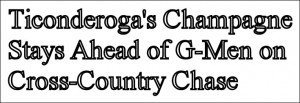 After impersonating Walter W. Baker, heir to the Baker chocolate fortune, and bilking his Richmond fiancee’s mother out of $15,000 in 1928 (equal to $197,000 in 2013), Ticonderoga’s Bernard Frederick Champagne was sentenced to ten years in a Virginia prison. He was paroled after serving more than six years, but the gates had hardly closed behind him when Champagne was at it again.
After impersonating Walter W. Baker, heir to the Baker chocolate fortune, and bilking his Richmond fiancee’s mother out of $15,000 in 1928 (equal to $197,000 in 2013), Ticonderoga’s Bernard Frederick Champagne was sentenced to ten years in a Virginia prison. He was paroled after serving more than six years, but the gates had hardly closed behind him when Champagne was at it again.
Shortly after his release, the US Department of Justice was tracking him across the North Country. As he had done for years in the past, Bernard managed to move quickly and stay a step ahead of his pursuers.
In retrospect, it probably wasn’t the best idea to leave prison after conviction on charges of impersonation and then return home to pass himself off as a federal officer, but that’s exactly what Champagne did. He also left Ticonderoga for several weeks with a vehicle that didn’t belong to him, prompting the town police force to join the feds in seeking his arrest.
Initially, their search efforts covered from the Albany area to southern Quebec. It was then expanded statewide, and finally extended across the Northeast. Two weeks later, Champagne was in Elizabethtown’s Essex County jail, facing local and federal charges.
What had he done? After arriving home from the prison in Virginia, Bernard needed transportation to execute his latest scam. At the automobile dealership of Charles Moore in Ticonderoga, he tried out a large Oldsmobile and expressed an interest in purchasing it. Moore accepted his promise to return with the car and pay for it when some expected funds arrived.
Champagne then visited stores, restaurants, and bars across the region, presenting himself as a representative from Washington. Presenting his official federal credentials, including a badge, Bernard saved them money by accepting a smaller direct payment of the liquor tax, which relieved them of paying the regular rate to county alcohol officials.
When local liquor authorities made their normal rounds, they viewed the receipts left by Champagne and knew immediately that something was amiss. By that time, he had scammed businesses across the region and then vanished.
An investigation failed to locate Bernard, but certain savings accounts were discovered. No one knew for certain where the money came from, but in banks located in Burlington and Saratoga, Champagne had $56,000 ($917,000 in 2013).
He was traced as far as Maryland, and then officially listed as “whereabouts unknown.” A week later, Champagne was arrested in Hyattsville, Maryland (still driving the Oldsmobile), and was brought north to face charges.
Five months later (in October), an Essex County jury found him not guilty of stealing the car. Their reasoning was simple: he had promised to return it, and with no firm timeframe in place, he hadn’t actually reneged on that promise.
As he had done earlier in the Richmond case, Bernard presented no defense on the federal charges. He pled guilty in Albany to three counts of impersonation and was sentenced to one year and one day in the US Penitentiary at Lewisburg, Pennsylvania.
In December 1936, Champagne walked out of prison once again a free man, and immediately proved himself an incorrigible lawbreaker. Without hesitation, he returned to criminal activity, and for the next several years left few traces of his whereabouts. (It was very difficult tracking his story today through newspaper archives and public records. Gaps were unavoidable. After all, seven decades ago, the FBI chased him for seven years before achieving any success.)
Having already served two prison sentences, Champagne had proven catchable, but the third time wouldn’t be easy for his pursuers. He worked multiple scams at the same time in a particular city, but when the heat was on, he slipped away to a new location. And there’s no denying that Bernard Champagne was one slippery customer.
His exploits out West provide a fine example. After several impersonations in San Francisco, he was indicted there by a federal grand jury in May 1942. But Champagne was already long gone, posing as a secret service agent in Salt Lake City, where he found at least six more victims. He was particularly adept at securing small cash amounts, which tended to attract less attention.
To make the process profitable, he worked several targets simultaneously. They were nearly always women, and many of them were widows. In Salt Lake City, impersonating a secret service agent netted him $5,000 from six targets. As if to intentionally taunt his pursuers, in two of those cases Bernard also claimed to be a special agent with the FBI.
This especially annoyed Bureau Director J. Edgar Hoover, who was very protective of the agency’s image. He turned up the heat on Bernard, but despite the intensified effort, their quarry from the North Country remained elusive.
The charges at San Francisco were followed by several other federal indictments: in Salt Lake City, June and November 1942- Danville, Illinois, September 1942- New York City, January 1943- and Cleveland, April 1943. Complaints had also been filed against Bernard in Omaha, Nebraska- Kankakee, Illinois- Daytona Beach, Florida- and in Maine.
Next week: The stunning depth of Champagne’s impersonations is revealed.